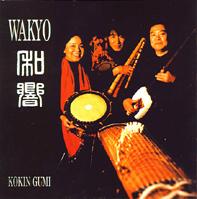Wakyo (Sound of Japan)

|
Kokin Gumi
Kokin Gumi's second recording is a collection of traditional
Japanese music pieces, played on traditional instruments with some
new arrangements by Masakazu Yoshizawa.
|
Contents of Wakyo
- SAKURA (Cherry Blossoms)
This work is undoubtedly the best known and
loved of all
traditional Japanese pieces. The anonymous
composer gives praise
to the representative symbol of
Japan - the cherry blossom.
This new arrangement is in
four sections:
- I. A Visual Appreciation
- II. The Flower Viewing Party
- III. Splendor of Evening Viewing
- IV. A Blizzard of Flowers
- KUMOIJISHI
This Shakuhachi solo is a work
originating during the early 17th century. It has been
transmitted by Zen monks at the temple of Itchoken
located in Hakata, Kyushu. Unlike the established
meditative pieces, this work was performed only in
the afternoon to console new monks who had come
from large lively cities - such as Osaka. It was played
with much spirit and freedom.
- KOJO NO TSUKI (Moon Over the Ruined Castle)
Equally popular as Sakura, Kojo no Tsuki has
been sought by many arrangers for various
instruments. After completing his university studies,
the composer Rentaro Taki traveled to Leipzig,
Germany to further his musical pursuits.
Unfortunately, he fell ill and had to return to Japan in
1902. He died at the young age of 24, but left a legacy
of brilliant compositions.
- MARI TO TONOSAMA (The Lord and the Bouncing Ball)
This humorous children's song by Shimpei
Nakayama is based on a fairy tale originating in
Wakayama Prefecture. It describes a child happily
bouncing a ball which accidentally lands inside of a
lordship's palanquin. The procession continues on. The
innocent child awaits, hoping that the ball will be
returned. However, as the fairy tale evolves, the ball tu
rns into a tangerine and thereafter, Wakayama becomes
noted as the tangerine capital.
- KOBAI (Plum Blossoms)
During the late 1 9th century, the
composer Koson Suzuki was recognized as the
founder of Kyogoku Style - the Renaissance revival
of Ancient Koto Music.
- The snow sprinkled upon the shore
- turns into glistening water
- and gradually melds into a stream.
- The restless heart yearns to journey
- through purple fields bursting with new leaves
- towards one's love.
- Translated from a poem by Ryukin Susukida
This particular performance is dedicated to the
memory of Yoko Gates.
- URESHIIHINAMATSURI
This children's song was written at the turn
of the century by Koyo Kawamura. An annual festival
was held on March 3rd to celebrate Girls' Day. It is now
known as the Festival of Dolls when families display
special dolls to honor their daughters.
- TSUGARU JONGARA BUSHI
Tsugaru encompasses the northeast
portion of Aomori Prefecture. The music and large
shamisen that developed in this region became
known as Tsugaru shamisen. Tsuganu Jongara Bushi
is one of the most important repertory of the
Tsuganu shamisen and begins with an improvisatory
introduction. Jongara is the name of a village and
the artist describes, through his shamisen, the
historical accounts of their existence.
- ITSUKI NO KOMORI UTA (The Lullaby of Itsuki)
Itsuki is a village located in Kumamoto
Prefecture. It is believed that the song evolved from
this village of Korean potters. It is in 3/4 time - a
meter unique to early Korea.
- HIDA FURUKAWA "ZENZENOKO"
This song originated in Hida Furukawa
approximately 400 years ago. It is a song of
celebration. In the song, Zenze means wealth and
mamma means rice. It is believed that centuries ago,
when a drought fell upon the land, a benevolent
lordship saved his people by giving them food and
money. The song reflects his kindness by expressing
that the joy of human kindness is more important than
material things.
Produced by: Masakazu Yoshizawa
Program Notes by Kayoko Wakita and Masakazu Yoshizawa
Selections 1, 3, 4, 6, 8 and 9 arranged by: MASAKAZU YOSHIZAWA
Performed by:
- MASAKAZU YOSHIZAWA - Shakuhachi, Shinobue, Hichiriki & Kotsuzumi
- HIROMI HASHIBE - Koto, Voice
- TATEO TAKAHASHI - Tsugaru Jamisen & Shime Taiko
Recorded: March 22-April 4,1997 on Roland VS-880
Typesetting and Graphic Arts by:
JANET YOSHIZAWA GRAPHIC ARTS
SERVICE
Special Thanks to:
- KAYOKO WAKITA
- NORIO FUNAHASHI
- KIMIKO TAKAHASHI
- CITY OF PHOENIX, ARIZONA
- CONSULATE GENERAL OF JAPAN IN ALASKA
- KATHERINE INOUE
- HIDA FURUKAWA, JAPAN
Management by:
SOUND CASTLE YOSHIZAWA
6696 Kimdale Rd.
San Gabriel, CA 91775-1740
91775
(626) 292-2551
Made in U.S.A.
To order Wakyo
Return to Discography of Kokin-Gumi
Return to Home Page
Copyright © 2002 Masakazu Yoshizawa

